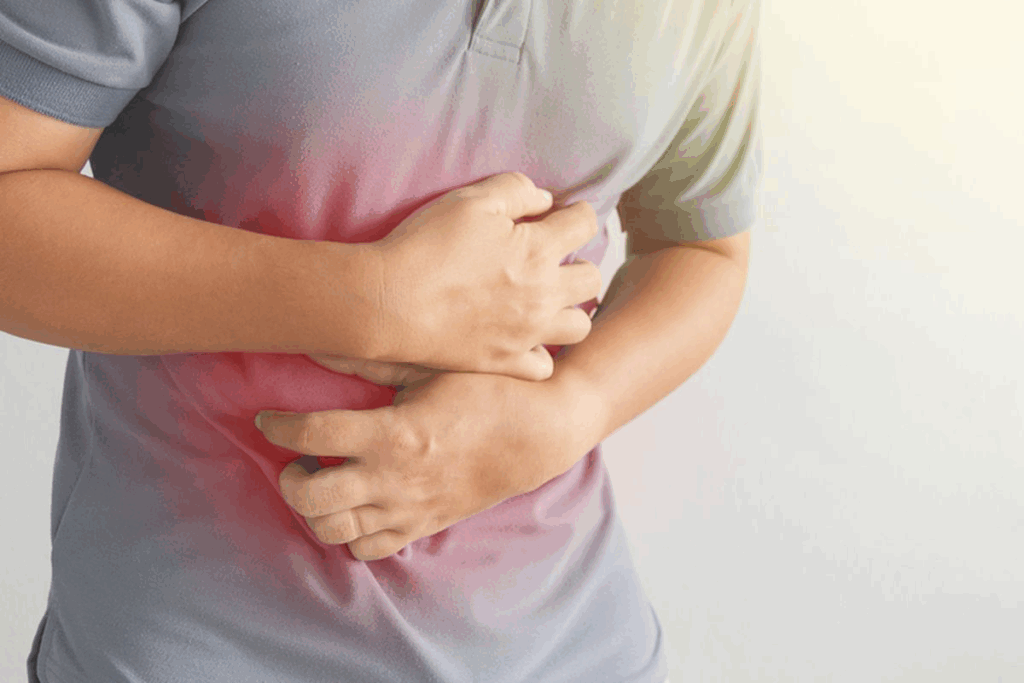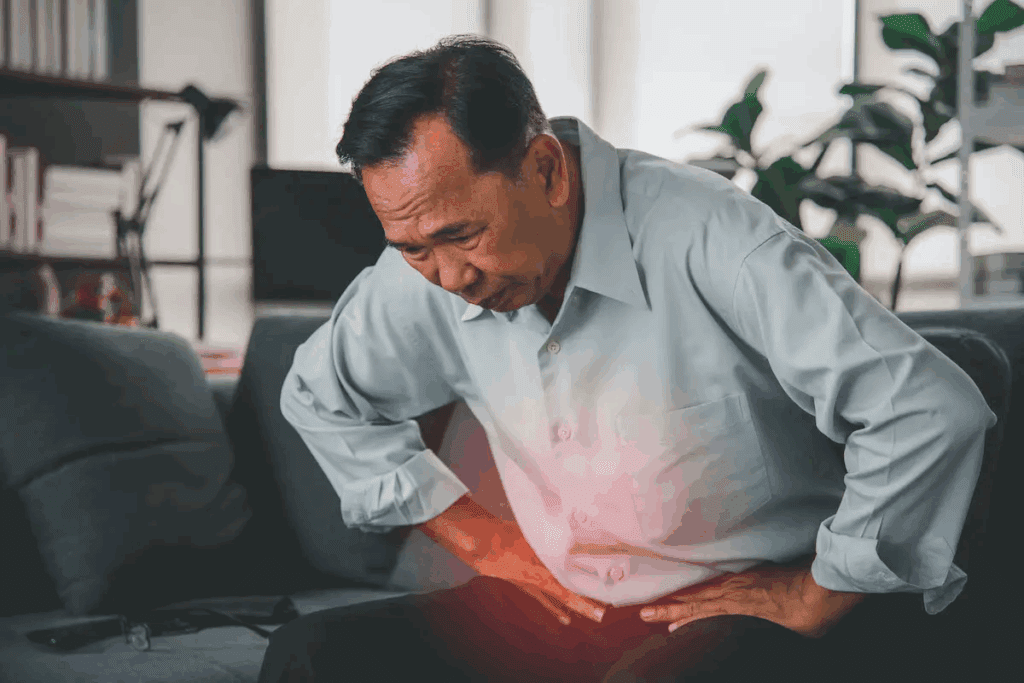Last Updated on November 26, 2025 by Bilal Hasdemir

Explore gallbladder stones ultrasound facts for accurate diagnosis and effective treatment. Finding gallstones can be tough, but ultrasound helps a lot. It lets doctors find gallstones quickly and treat them well. Many people get gallbladder pain and go to the doctor because of it.
At Liv Hospital, top doctors use advanced ultrasound technology. They can spot gallstones as small as 2mm with 90% accuracy. This tool is key for finding out what’s wrong and deciding how to treat it.

Gallstones are hard deposits that form in the gallbladder. This small organ is under the liver and stores bile.
Gallstones are mainly made of cholesterol and bilirubin. Cholesterol gallstones are yellowish and happen when bile has too much cholesterol. Bilirubin gallstones are black or dark brown and linked to red blood cell breakdown issues.
“About 80% of gallstones are cholesterol stones,” research shows. Gallstone formation is complex, involving many factors like cholesterol and bilirubin levels in bile.
Several factors increase gallstone risk. These include:
A medical expert notes, “Managing risk factors is key to preventing gallstones and avoiding complications.”

It’s important to know the signs of gallstones to avoid serious problems. Gallstones can cause different symptoms that can really affect your life.
Pain from gallstones usually happens in the right upper abdomen. It’s just below the rib cage. This pain, called biliary colic, can also spread to the right shoulder or back. The pain’s location and how bad it is can change based on the gallstone’s size and where it is.
Gallstone pain can last from a few minutes to hours. How long it lasts depends on if the stone blocks a duct or moves into the intestine. Sometimes, the pain goes away only to come back later.
Yes, gallstones can make you feel sick and want to vomit. If a stone blocks the bile duct, it can cause severe nausea and vomiting. These symptoms often happen with the stomach pain and can really affect how you feel overall.
Gallstones can cause constipation and bloating by blocking bile flow. Bile helps digest fats and absorb vitamins. When bile can’t flow right, it can cause digestive problems like bloating and changes in bowel movements.
Knowing these symptoms is key to getting help fast. Early treatment can stop serious problems and help people with gallstones feel better.
Gallbladder stones ultrasound is a non-invasive way to find gallstones. It’s become the main tool because it’s very accurate. It can spot stones as small as 2mm.
Ultrasound uses sound waves to see inside the gallbladder. Doctors can see stones and know their size and where they are. Modern ultrasound can find stones as small as 2mm, making it very good at finding them.
The process involves:
The ultrasound’s accuracy is a big plus. It has a 90% specificity rate. This means it’s very good at telling who doesn’t have gallstones.
A high specificity rate means:
Knowing what to expect can make you feel better. The ultrasound is usually painless and easy.
Here’s what you can expect:
After the test, a radiologist will look at the pictures. Then, your doctor will share the results with you.
It’s important to know the signs of gallstone complications to get help quickly. Gallstones can cause problems that show up in different ways.
Jaundice is a key sign of gallstone trouble. It makes your skin and eyes turn yellow. This happens when a gallstone blocks the bile duct, causing bilirubin to build up.
Jaundice is a serious sign that needs quick medical help. It often comes with tiredness and loss of appetite.
Itching, or pruritus, is another sign of gallstone trouble. Bile salts in the skin can make you itch a lot. This can be very uncomfortable and affect your daily life.
Dark urine is a sign that bilirubin isn’t being released into the intestine right. It gets into the bloodstream and then into the urine, making it dark. This symptom often goes with jaundice.
Gallstones can also change how your stool looks. If bile flow is blocked, your stools might be pale or clay-colored. Sometimes, they might even be greasy or float in the toilet.
| Symptom | Description | Possible Complication |
| Jaundice | Yellowing of skin and eyes | Bile duct obstruction |
| Itching | Intense skin itching | Bile salt buildup |
| Dark Urine | Urine appears dark | Bilirubin buildup |
| Changes in Stool | Pale, clay-colored, or greasy stools | Bile flow obstruction |
If left untreated, gallstones can lead to serious and potentially life-threatening complications. Gallstones are not just a minor issue; they can cause significant health problems if not addressed properly.
One serious complication of untreated gallstones is acute cholecystitis. This is an inflammation of the gallbladder. It happens when a gallstone blocks the cystic duct, stopping bile from leaving the gallbladder.
As a result, the gallbladder gets inflamed. This leads to severe pain and can cause a life-threatening infection.
Symptoms of Acute Cholecystitis:
Gallstones can also block the common bile duct. This prevents bile from flowing into the intestine. It leads to a buildup of bilirubin in the blood.
The consequences include jaundice, dark urine, and pale stools.
| Condition | Symptoms | Complications |
| Bile Duct Obstruction | Jaundice, dark urine, pale stools | Infection, liver damage |
| Acute Cholecystitis | Severe abdominal pain, fever, nausea | Gallbladder rupture, infection |
| Gallstone Pancreatitis | Severe abdominal pain, nausea, vomiting | Pancreatic damage, infection |
Gallstone pancreatitis happens when a gallstone blocks the pancreatic duct. This causes inflammation of the pancreas. It’s very painful and can damage the pancreas and cause infection.
Understanding these complications shows why it’s important to seek medical help if symptoms get worse. Early treatment can greatly reduce the risk of serious problems.
Managing gallstone pain needs a mix of medicine and knowing when to get medical help. It’s key to avoid complications and improve life quality.
For those with gallstone pain, over-the-counter pain relievers like ibuprofen can help. Ibuprofen is often suggested because it can reduce inflammation and ease pain. But, always follow the dosage and talk to a doctor, mainly if you have stomach issues or take other meds.
A study in the Journal of Clinical Gastroenterology shows NSAIDs like ibuprofen work well for acute biliary colic. Yet, it’s important to know the side effects and the limits of long-term use.
| Pain Reliever | Dosage | Precautions |
| Ibuprofen | 200-400 mg every 4-6 hours | Avoid in patients with active peptic ulcer disease |
| Acetaminophen | 500-1000 mg every 6 hours | Use with caution in patients with liver disease |
While you can manage gallstone pain at home, some situations need immediate medical help. Severe abdominal pain, fever, chills, or jaundice mean you should go to the emergency room. These could be signs of serious issues like cholecystitis or pancreatitis.
“Severe or persistent abdominal pain, when you have fever or jaundice, needs immediate emergency care.”
It’s also important to know the signs of gallstone complications. Below is a table with these signs:
| Symptom | Description | Action |
| Severe Abdominal Pain | Pain that is intense and unrelenting | Seek Emergency Care |
| Fever and Chills | Indicative of possible infection | Seek Emergency Care |
| Jaundice | Yellowing of the skin and eyes | Seek Medical Attention |
In conclusion, managing gallstone pain well needs the right medicine and knowing when to get medical help. Knowing your options and the signs of complications helps you handle your treatment better.
There are many ways to treat gallstones, from natural methods to surgery. The right treatment depends on the stone’s size, how bad the symptoms are, and the patient’s health.
Some people try to pass gallstones on their own. They might change their diet or take certain medicines. But, this method works best for small stones, less than 5mm.
Dietary changes are key in trying to pass gallstones naturally. Eating more unsaturated fats and fiber can help move small stones.
For those who can’t pass stones naturally or have bigger ones, doctors might suggest medical help. Ursodeoxycholic acid (UDCA) therapy can dissolve some gallstones over time.
Here’s a look at different medical treatments:
| Treatment | Description | Effectiveness |
| UDCA Therapy | Dissolves cholesterol gallstones | Works for small stones |
| Extracorporeal Shock Wave Lithotripsy (ESWL) | Breaks stones into smaller pieces | Good for bigger stones, often with UDCA |
Cholecystectomy, or removing the gallbladder, is often the best choice. This surgery is usually done laparoscopically, making recovery faster.
Recovering from cholecystectomy takes a few weeks. Patients might need to eat a special diet to handle any digestive changes.
Preventing gallstones is possible with the right diet and lifestyle. Knowing what causes gallstones helps you take steps to lower your risk.
Eating more fruits, vegetables, and whole grains can help prevent gallstones. Increasing fiber intake is key to reducing gallstone risk.
It’s also important to watch your fat intake. While some fat is good, choosing healthier fats like olive oil, nuts, and avocados is better.
Changing your lifestyle can also help prevent gallstones. Regular physical activity is vital for a healthy weight and digestion.
Drinking plenty of water is also key for health and preventing gallstones.
Getting a gallstone diagnosis can be scary. But, with the right treatment and lifestyle changes, you can live well. Gallstones are usually made of cholesterol and bilirubin. Knowing this helps manage the condition better.
To live with gallstones, it’s important to know the symptoms. Taking steps to prevent problems is key. Making healthy food choices and living a healthy lifestyle can help a lot.
After finding out you have gallstones, talk to your doctor about treatment. This way, you can feel better, avoid more gallstones, and stay healthy.
Yes, gallstones can cause nausea and vomiting. This happens if they block the bile duct or cause inflammation in the gallbladder.
Gallstones are made of cholesterol and bilirubin. These substances can accumulate and harden in the gallbladder.
Ibuprofen might help with mild gallbladder pain. But, it’s important to talk to a doctor first. It might not be right for everyone.
Yes, gallstones can disrupt bile flow. This can lead to constipation and bloating.
Complications include jaundice, itching, dark urine, and changes in stool. These are signs you need to see a doctor.
Pain from gallstones can last a few hours. But, some cases need medical help.
Yes, you can lower your risk. Eat well, stay healthy, and avoid obesity. These steps can help prevent gallstones.
Ultrasound is the main tool for finding gallstones. It’s accurate and doesn’t hurt.
Yes, gallstones can make you itch. This happens if they block the bile duct and cause bile salts to build up in the skin.
Pain from gallstones is usually in the upper right abdomen. It can also spread to the right shoulder or back.
You can try to pass gallstones naturally, use medicine, or have surgery. Cholecystectomy is a common surgery for gallstones.
No, you can’t feel gallstones with your fingers. They are small and inside the gallbladder.
Untreated gallstones can cause serious problems. These include inflammation, blockage, and pancreatitis.
Subscribe to our e-newsletter to stay informed about the latest innovations in the world of health and exclusive offers!